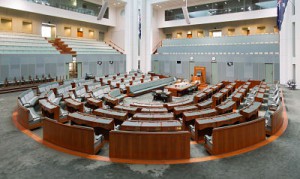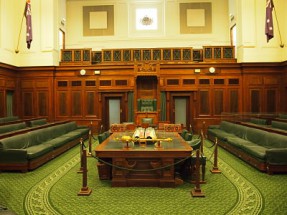
Genuinely worn leather upholstery and naturally aged and faded carpets might be a hot trend amongst hip home renovators and trendy Bohemian bars and cafes … but at Parliament House Canberra, that lived-in, shabby chic look is out the door and in the skip.
As politicians around the country resumed their seats in the big house for the first sitting of 2016, the Department of Parliamentary Services (DPS) has gone window shopping to replace the very upholstery and carpets underneath members sitting in the Parliamentary chambers.
A casting call has been issued to prospective suppliers to manufacture or provide (read import) materials for the “main chamber”, with Parliament specifically looking for companies that have “sufficient capacity to provide the necessary quantities and to a quality befitting such an important building.”
The beauty parade for what will be a huge interior make-over comes amid continuing fallout over the cost of protracted renovations to the PM’s official Canberra residence, The Lodge (built 1927), a renovation that started at $3.19 million, then ballooned to $9.4 million and could now hit between $12 million and $15 million – a blowout that has prompted a new independent audit, according to reports.
Amid such sensitivities, the Department of Parliamentary services isn’t exactly putting its hands up and shouting about any plans for a swank interior update for the nation’s politicians.
Asked directly if there were plans to reupholster and recarpet the House of Representatives, the Senate – or both – a DPS spokesperson replied that “the ongoing maintenance for Australian Parliament House requires periodic testing of the market to establish the availability of materials that are fit for purpose.”
But going by the sheer quantities of material cited by DPS, re-covering surfaces in Parliament’s chambers looks more like a military logistics exercise than a shoot for Vogue Living and could put the pinch on the luxury leather market.
At the top of Parliament’s shopping list are:
- Approximately 1,200m2 of hand-tufted carpet dyed in two different colours
- Approximately 500m2 of nappa leather dyed in three different colours
- Approximately 400m2 of high quality wool fabric dyed in two different colours
With those kinds of dimensions, a primary concern is clearly making sure suppliers can get their hands on enough of the required materials to complete the job, with DPS asking that suppliers state “any limitation on the quantity of material that can be provided.”
Seasoned political staffers inside Parliament House have told Government News they believe that reference to different colours strongly suggests that both the Lower and Upper House chambers are set for refurbishment. It’s also understood that any timing for a renovation would be necessarily contingent on the availability of the materials neccessary.
Ethically sourcing the carpet, fabric and leather is cited as another consideration in the documents, a clear signal supply chains shouldn’t include sweatshops.
But getting Australian made materials for the job could be harder than it first appears.
When Parliament House opened in 1988, the extensive use of the finest Australian materials and craftsmanship ranging from parquetry and cabinet work to stone and marble was a major cause for celebration.
In the case of the leather in the chambers, it was sourced locally from Melbourne’s Howe Leather – which remains one of the few tanneries still operating in Australia when most hide processing has been moved offshore to destinations like China.
According to Howe’s website, the company also supplied the leather for seats in Old Parliament House built in 1927.
But while Howe’s leather business is still going strong, providing a comfortable seat for Representatives and Senators might not be at the top of its agenda anymore as the company now specialises in top quality automotive leather for the likes of Audi, Mercedes, Rover, Nissan, Toyota and Ford.
The head office at Howe’s Perth based parent company Schaffer Corporation would not talk to the parliamentary call for leather, but it did advise that it was no longer in the furniture market. It seems to be what happens when a business takes a leaf from the PM’s Innovation Agenda and diversifies into more sophisticated, higher margin products and export markets.
Genuine Australian premium leather is still available in Australia. It just comes in imported cars.
Comment below to have your say on this story.
If you have a news story or tip-off, get in touch at editorial@governmentnews.com.au.
Sign up to the Government News newsletter
